Workplace Equality and Diversity: A Report on Cultural Differences
VerifiedAdded on 2023/01/10
|26
|5651
|51
Report
AI Summary
This report delves into the crucial concepts of equality and diversity within the workplace, emphasizing the importance of managing cultural differences for organizational success. The research aims to understand how cultural differences are managed, focusing on a case study of Treves and Hyde restaurant. Objectives include evaluating current procedures and investigating how equality is initiated by diminishing cultural differences. The report explores these questions through a literature review, examining various strategies like communication, team building, and cultural awareness. The research methodology includes primary methods such as surveys and questionnaires to gather first-hand data, supplemented by secondary methods. The report also addresses ethical considerations and data analysis, concluding with recommendations for promoting equality and diversity. Alternative research methodologies are also considered to enhance the study's findings.

Assignment
Paraphrase This Document
Need a fresh take? Get an instant paraphrase of this document with our AI Paraphraser
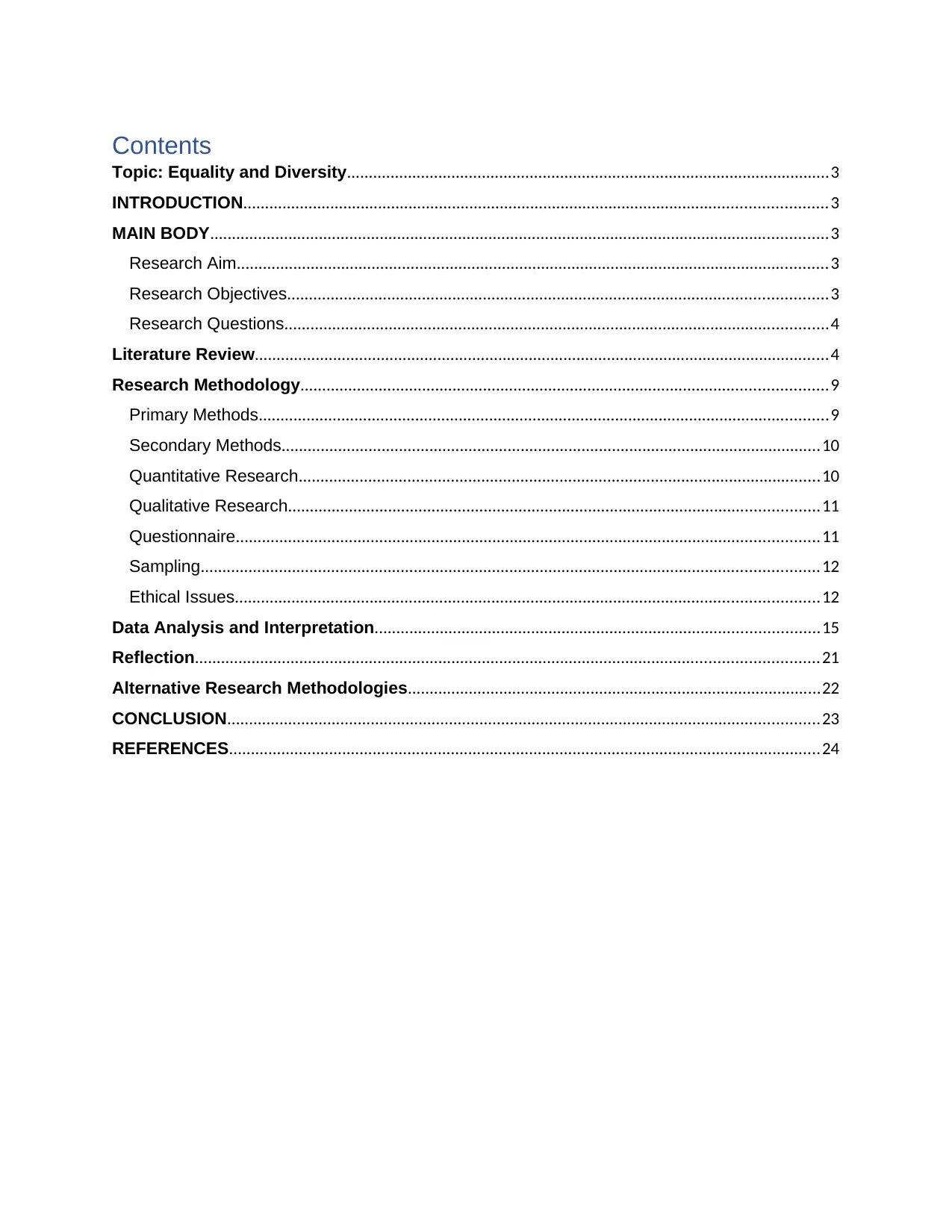
Contents
Topic: Equality and Diversity...............................................................................................................3
INTRODUCTION......................................................................................................................................3
MAIN BODY..............................................................................................................................................3
Research Aim........................................................................................................................................3
Research Objectives............................................................................................................................3
Research Questions.............................................................................................................................4
Literature Review....................................................................................................................................4
Research Methodology.........................................................................................................................9
Primary Methods...................................................................................................................................9
Secondary Methods............................................................................................................................10
Quantitative Research........................................................................................................................10
Qualitative Research..........................................................................................................................11
Questionnaire......................................................................................................................................11
Sampling..............................................................................................................................................12
Ethical Issues......................................................................................................................................12
Data Analysis and Interpretation......................................................................................................15
Reflection...............................................................................................................................................21
Alternative Research Methodologies...............................................................................................22
CONCLUSION........................................................................................................................................23
REFERENCES........................................................................................................................................24
Topic: Equality and Diversity...............................................................................................................3
INTRODUCTION......................................................................................................................................3
MAIN BODY..............................................................................................................................................3
Research Aim........................................................................................................................................3
Research Objectives............................................................................................................................3
Research Questions.............................................................................................................................4
Literature Review....................................................................................................................................4
Research Methodology.........................................................................................................................9
Primary Methods...................................................................................................................................9
Secondary Methods............................................................................................................................10
Quantitative Research........................................................................................................................10
Qualitative Research..........................................................................................................................11
Questionnaire......................................................................................................................................11
Sampling..............................................................................................................................................12
Ethical Issues......................................................................................................................................12
Data Analysis and Interpretation......................................................................................................15
Reflection...............................................................................................................................................21
Alternative Research Methodologies...............................................................................................22
CONCLUSION........................................................................................................................................23
REFERENCES........................................................................................................................................24
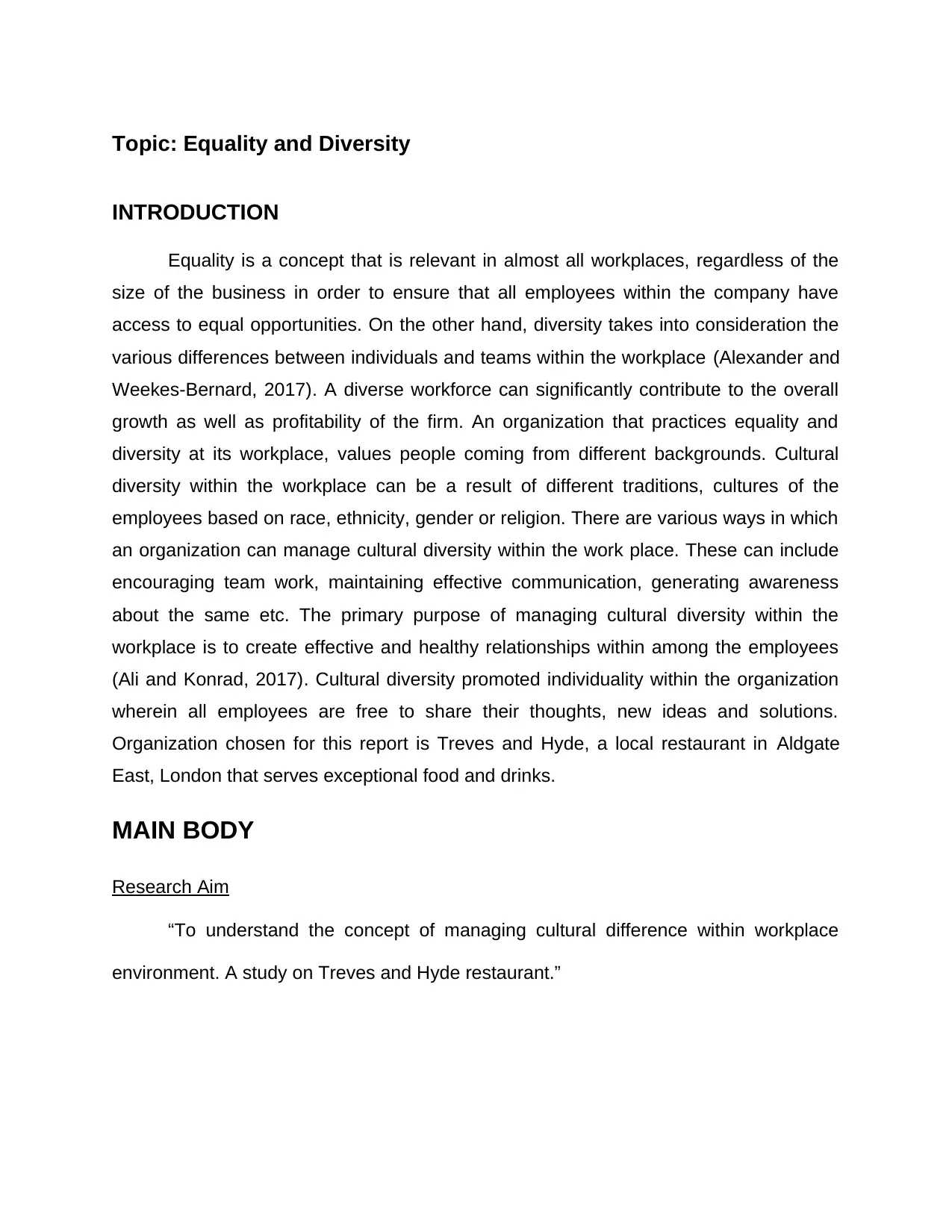
Topic: Equality and Diversity
INTRODUCTION
Equality is a concept that is relevant in almost all workplaces, regardless of the
size of the business in order to ensure that all employees within the company have
access to equal opportunities. On the other hand, diversity takes into consideration the
various differences between individuals and teams within the workplace (Alexander and
Weekes-Bernard, 2017). A diverse workforce can significantly contribute to the overall
growth as well as profitability of the firm. An organization that practices equality and
diversity at its workplace, values people coming from different backgrounds. Cultural
diversity within the workplace can be a result of different traditions, cultures of the
employees based on race, ethnicity, gender or religion. There are various ways in which
an organization can manage cultural diversity within the work place. These can include
encouraging team work, maintaining effective communication, generating awareness
about the same etc. The primary purpose of managing cultural diversity within the
workplace is to create effective and healthy relationships within among the employees
(Ali and Konrad, 2017). Cultural diversity promoted individuality within the organization
wherein all employees are free to share their thoughts, new ideas and solutions.
Organization chosen for this report is Treves and Hyde, a local restaurant in Aldgate
East, London that serves exceptional food and drinks.
MAIN BODY
Research Aim
“To understand the concept of managing cultural difference within workplace
environment. A study on Treves and Hyde restaurant.”
INTRODUCTION
Equality is a concept that is relevant in almost all workplaces, regardless of the
size of the business in order to ensure that all employees within the company have
access to equal opportunities. On the other hand, diversity takes into consideration the
various differences between individuals and teams within the workplace (Alexander and
Weekes-Bernard, 2017). A diverse workforce can significantly contribute to the overall
growth as well as profitability of the firm. An organization that practices equality and
diversity at its workplace, values people coming from different backgrounds. Cultural
diversity within the workplace can be a result of different traditions, cultures of the
employees based on race, ethnicity, gender or religion. There are various ways in which
an organization can manage cultural diversity within the work place. These can include
encouraging team work, maintaining effective communication, generating awareness
about the same etc. The primary purpose of managing cultural diversity within the
workplace is to create effective and healthy relationships within among the employees
(Ali and Konrad, 2017). Cultural diversity promoted individuality within the organization
wherein all employees are free to share their thoughts, new ideas and solutions.
Organization chosen for this report is Treves and Hyde, a local restaurant in Aldgate
East, London that serves exceptional food and drinks.
MAIN BODY
Research Aim
“To understand the concept of managing cultural difference within workplace
environment. A study on Treves and Hyde restaurant.”
⊘ This is a preview!⊘
Do you want full access?
Subscribe today to unlock all pages.

Trusted by 1+ million students worldwide
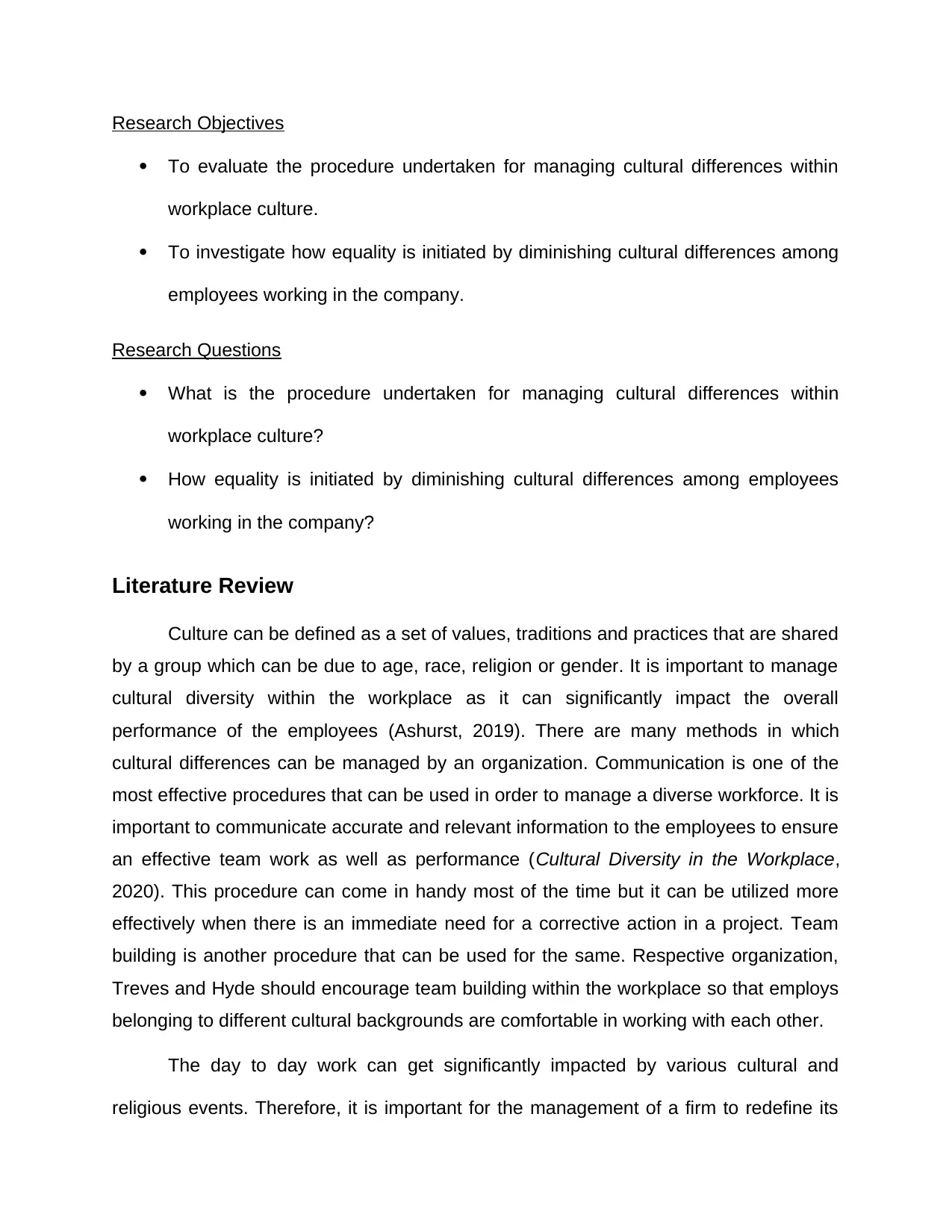
Research Objectives
To evaluate the procedure undertaken for managing cultural differences within
workplace culture.
To investigate how equality is initiated by diminishing cultural differences among
employees working in the company.
Research Questions
What is the procedure undertaken for managing cultural differences within
workplace culture?
How equality is initiated by diminishing cultural differences among employees
working in the company?
Literature Review
Culture can be defined as a set of values, traditions and practices that are shared
by a group which can be due to age, race, religion or gender. It is important to manage
cultural diversity within the workplace as it can significantly impact the overall
performance of the employees (Ashurst, 2019). There are many methods in which
cultural differences can be managed by an organization. Communication is one of the
most effective procedures that can be used in order to manage a diverse workforce. It is
important to communicate accurate and relevant information to the employees to ensure
an effective team work as well as performance (Cultural Diversity in the Workplace,
2020). This procedure can come in handy most of the time but it can be utilized more
effectively when there is an immediate need for a corrective action in a project. Team
building is another procedure that can be used for the same. Respective organization,
Treves and Hyde should encourage team building within the workplace so that employs
belonging to different cultural backgrounds are comfortable in working with each other.
The day to day work can get significantly impacted by various cultural and
religious events. Therefore, it is important for the management of a firm to redefine its
To evaluate the procedure undertaken for managing cultural differences within
workplace culture.
To investigate how equality is initiated by diminishing cultural differences among
employees working in the company.
Research Questions
What is the procedure undertaken for managing cultural differences within
workplace culture?
How equality is initiated by diminishing cultural differences among employees
working in the company?
Literature Review
Culture can be defined as a set of values, traditions and practices that are shared
by a group which can be due to age, race, religion or gender. It is important to manage
cultural diversity within the workplace as it can significantly impact the overall
performance of the employees (Ashurst, 2019). There are many methods in which
cultural differences can be managed by an organization. Communication is one of the
most effective procedures that can be used in order to manage a diverse workforce. It is
important to communicate accurate and relevant information to the employees to ensure
an effective team work as well as performance (Cultural Diversity in the Workplace,
2020). This procedure can come in handy most of the time but it can be utilized more
effectively when there is an immediate need for a corrective action in a project. Team
building is another procedure that can be used for the same. Respective organization,
Treves and Hyde should encourage team building within the workplace so that employs
belonging to different cultural backgrounds are comfortable in working with each other.
The day to day work can get significantly impacted by various cultural and
religious events. Therefore, it is important for the management of a firm to redefine its
Paraphrase This Document
Need a fresh take? Get an instant paraphrase of this document with our AI Paraphraser
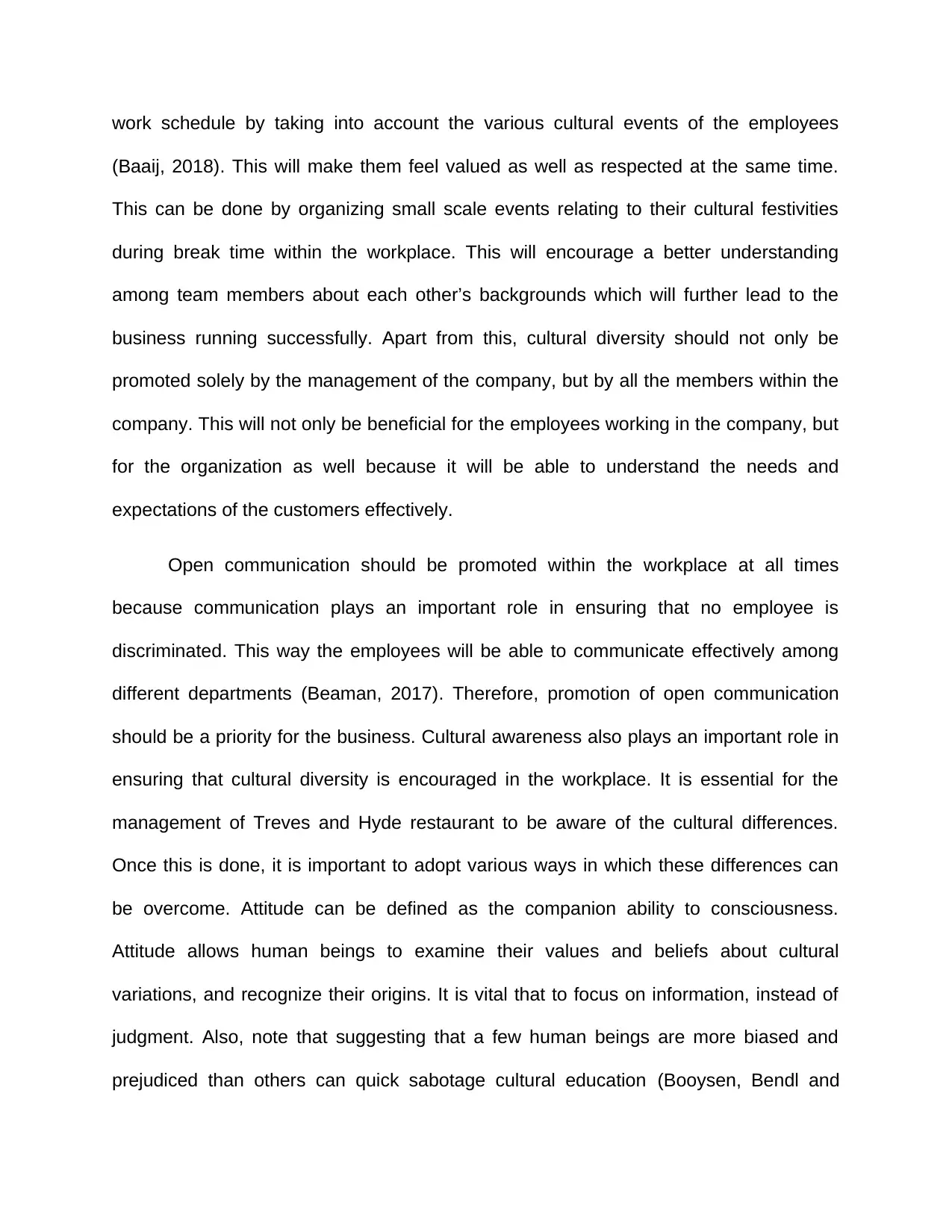
work schedule by taking into account the various cultural events of the employees
(Baaij, 2018). This will make them feel valued as well as respected at the same time.
This can be done by organizing small scale events relating to their cultural festivities
during break time within the workplace. This will encourage a better understanding
among team members about each other’s backgrounds which will further lead to the
business running successfully. Apart from this, cultural diversity should not only be
promoted solely by the management of the company, but by all the members within the
company. This will not only be beneficial for the employees working in the company, but
for the organization as well because it will be able to understand the needs and
expectations of the customers effectively.
Open communication should be promoted within the workplace at all times
because communication plays an important role in ensuring that no employee is
discriminated. This way the employees will be able to communicate effectively among
different departments (Beaman, 2017). Therefore, promotion of open communication
should be a priority for the business. Cultural awareness also plays an important role in
ensuring that cultural diversity is encouraged in the workplace. It is essential for the
management of Treves and Hyde restaurant to be aware of the cultural differences.
Once this is done, it is important to adopt various ways in which these differences can
be overcome. Attitude can be defined as the companion ability to consciousness.
Attitude allows human beings to examine their values and beliefs about cultural
variations, and recognize their origins. It is vital that to focus on information, instead of
judgment. Also, note that suggesting that a few human beings are more biased and
prejudiced than others can quick sabotage cultural education (Booysen, Bendl and
(Baaij, 2018). This will make them feel valued as well as respected at the same time.
This can be done by organizing small scale events relating to their cultural festivities
during break time within the workplace. This will encourage a better understanding
among team members about each other’s backgrounds which will further lead to the
business running successfully. Apart from this, cultural diversity should not only be
promoted solely by the management of the company, but by all the members within the
company. This will not only be beneficial for the employees working in the company, but
for the organization as well because it will be able to understand the needs and
expectations of the customers effectively.
Open communication should be promoted within the workplace at all times
because communication plays an important role in ensuring that no employee is
discriminated. This way the employees will be able to communicate effectively among
different departments (Beaman, 2017). Therefore, promotion of open communication
should be a priority for the business. Cultural awareness also plays an important role in
ensuring that cultural diversity is encouraged in the workplace. It is essential for the
management of Treves and Hyde restaurant to be aware of the cultural differences.
Once this is done, it is important to adopt various ways in which these differences can
be overcome. Attitude can be defined as the companion ability to consciousness.
Attitude allows human beings to examine their values and beliefs about cultural
variations, and recognize their origins. It is vital that to focus on information, instead of
judgment. Also, note that suggesting that a few human beings are more biased and
prejudiced than others can quick sabotage cultural education (Booysen, Bendl and
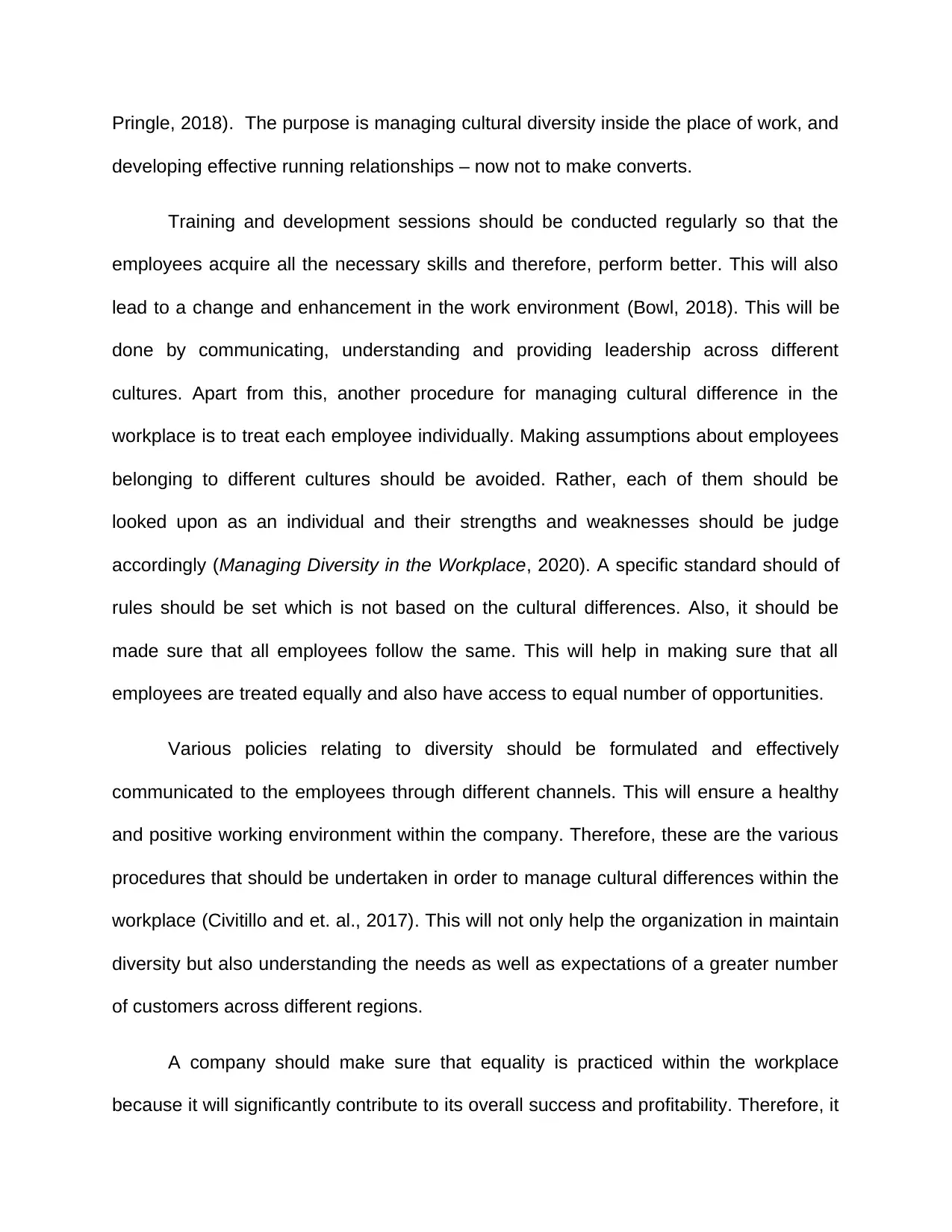
Pringle, 2018). The purpose is managing cultural diversity inside the place of work, and
developing effective running relationships – now not to make converts.
Training and development sessions should be conducted regularly so that the
employees acquire all the necessary skills and therefore, perform better. This will also
lead to a change and enhancement in the work environment (Bowl, 2018). This will be
done by communicating, understanding and providing leadership across different
cultures. Apart from this, another procedure for managing cultural difference in the
workplace is to treat each employee individually. Making assumptions about employees
belonging to different cultures should be avoided. Rather, each of them should be
looked upon as an individual and their strengths and weaknesses should be judge
accordingly (Managing Diversity in the Workplace, 2020). A specific standard should of
rules should be set which is not based on the cultural differences. Also, it should be
made sure that all employees follow the same. This will help in making sure that all
employees are treated equally and also have access to equal number of opportunities.
Various policies relating to diversity should be formulated and effectively
communicated to the employees through different channels. This will ensure a healthy
and positive working environment within the company. Therefore, these are the various
procedures that should be undertaken in order to manage cultural differences within the
workplace (Civitillo and et. al., 2017). This will not only help the organization in maintain
diversity but also understanding the needs as well as expectations of a greater number
of customers across different regions.
A company should make sure that equality is practiced within the workplace
because it will significantly contribute to its overall success and profitability. Therefore, it
developing effective running relationships – now not to make converts.
Training and development sessions should be conducted regularly so that the
employees acquire all the necessary skills and therefore, perform better. This will also
lead to a change and enhancement in the work environment (Bowl, 2018). This will be
done by communicating, understanding and providing leadership across different
cultures. Apart from this, another procedure for managing cultural difference in the
workplace is to treat each employee individually. Making assumptions about employees
belonging to different cultures should be avoided. Rather, each of them should be
looked upon as an individual and their strengths and weaknesses should be judge
accordingly (Managing Diversity in the Workplace, 2020). A specific standard should of
rules should be set which is not based on the cultural differences. Also, it should be
made sure that all employees follow the same. This will help in making sure that all
employees are treated equally and also have access to equal number of opportunities.
Various policies relating to diversity should be formulated and effectively
communicated to the employees through different channels. This will ensure a healthy
and positive working environment within the company. Therefore, these are the various
procedures that should be undertaken in order to manage cultural differences within the
workplace (Civitillo and et. al., 2017). This will not only help the organization in maintain
diversity but also understanding the needs as well as expectations of a greater number
of customers across different regions.
A company should make sure that equality is practiced within the workplace
because it will significantly contribute to its overall success and profitability. Therefore, it
⊘ This is a preview!⊘
Do you want full access?
Subscribe today to unlock all pages.

Trusted by 1+ million students worldwide
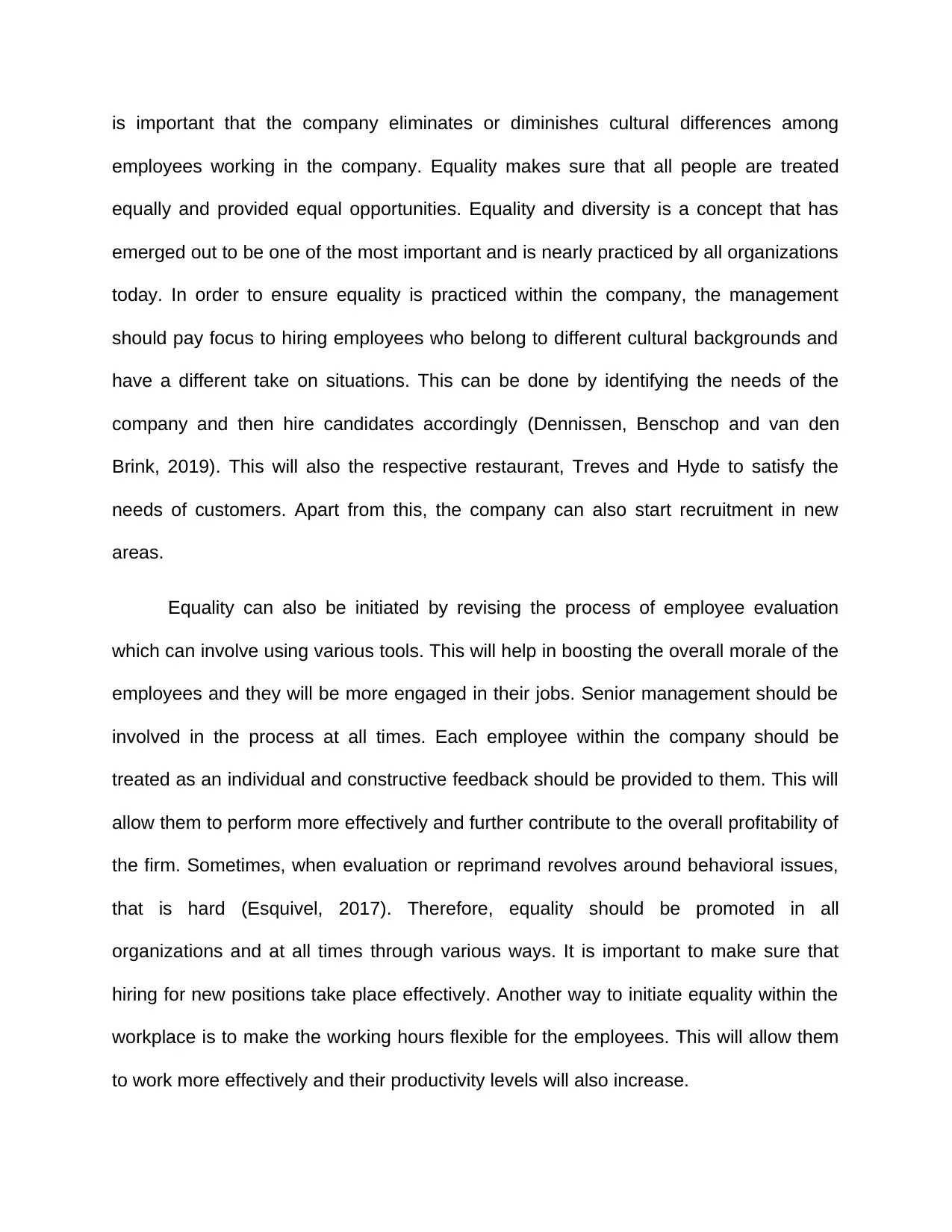
is important that the company eliminates or diminishes cultural differences among
employees working in the company. Equality makes sure that all people are treated
equally and provided equal opportunities. Equality and diversity is a concept that has
emerged out to be one of the most important and is nearly practiced by all organizations
today. In order to ensure equality is practiced within the company, the management
should pay focus to hiring employees who belong to different cultural backgrounds and
have a different take on situations. This can be done by identifying the needs of the
company and then hire candidates accordingly (Dennissen, Benschop and van den
Brink, 2019). This will also the respective restaurant, Treves and Hyde to satisfy the
needs of customers. Apart from this, the company can also start recruitment in new
areas.
Equality can also be initiated by revising the process of employee evaluation
which can involve using various tools. This will help in boosting the overall morale of the
employees and they will be more engaged in their jobs. Senior management should be
involved in the process at all times. Each employee within the company should be
treated as an individual and constructive feedback should be provided to them. This will
allow them to perform more effectively and further contribute to the overall profitability of
the firm. Sometimes, when evaluation or reprimand revolves around behavioral issues,
that is hard (Esquivel, 2017). Therefore, equality should be promoted in all
organizations and at all times through various ways. It is important to make sure that
hiring for new positions take place effectively. Another way to initiate equality within the
workplace is to make the working hours flexible for the employees. This will allow them
to work more effectively and their productivity levels will also increase.
employees working in the company. Equality makes sure that all people are treated
equally and provided equal opportunities. Equality and diversity is a concept that has
emerged out to be one of the most important and is nearly practiced by all organizations
today. In order to ensure equality is practiced within the company, the management
should pay focus to hiring employees who belong to different cultural backgrounds and
have a different take on situations. This can be done by identifying the needs of the
company and then hire candidates accordingly (Dennissen, Benschop and van den
Brink, 2019). This will also the respective restaurant, Treves and Hyde to satisfy the
needs of customers. Apart from this, the company can also start recruitment in new
areas.
Equality can also be initiated by revising the process of employee evaluation
which can involve using various tools. This will help in boosting the overall morale of the
employees and they will be more engaged in their jobs. Senior management should be
involved in the process at all times. Each employee within the company should be
treated as an individual and constructive feedback should be provided to them. This will
allow them to perform more effectively and further contribute to the overall profitability of
the firm. Sometimes, when evaluation or reprimand revolves around behavioral issues,
that is hard (Esquivel, 2017). Therefore, equality should be promoted in all
organizations and at all times through various ways. It is important to make sure that
hiring for new positions take place effectively. Another way to initiate equality within the
workplace is to make the working hours flexible for the employees. This will allow them
to work more effectively and their productivity levels will also increase.
Paraphrase This Document
Need a fresh take? Get an instant paraphrase of this document with our AI Paraphraser
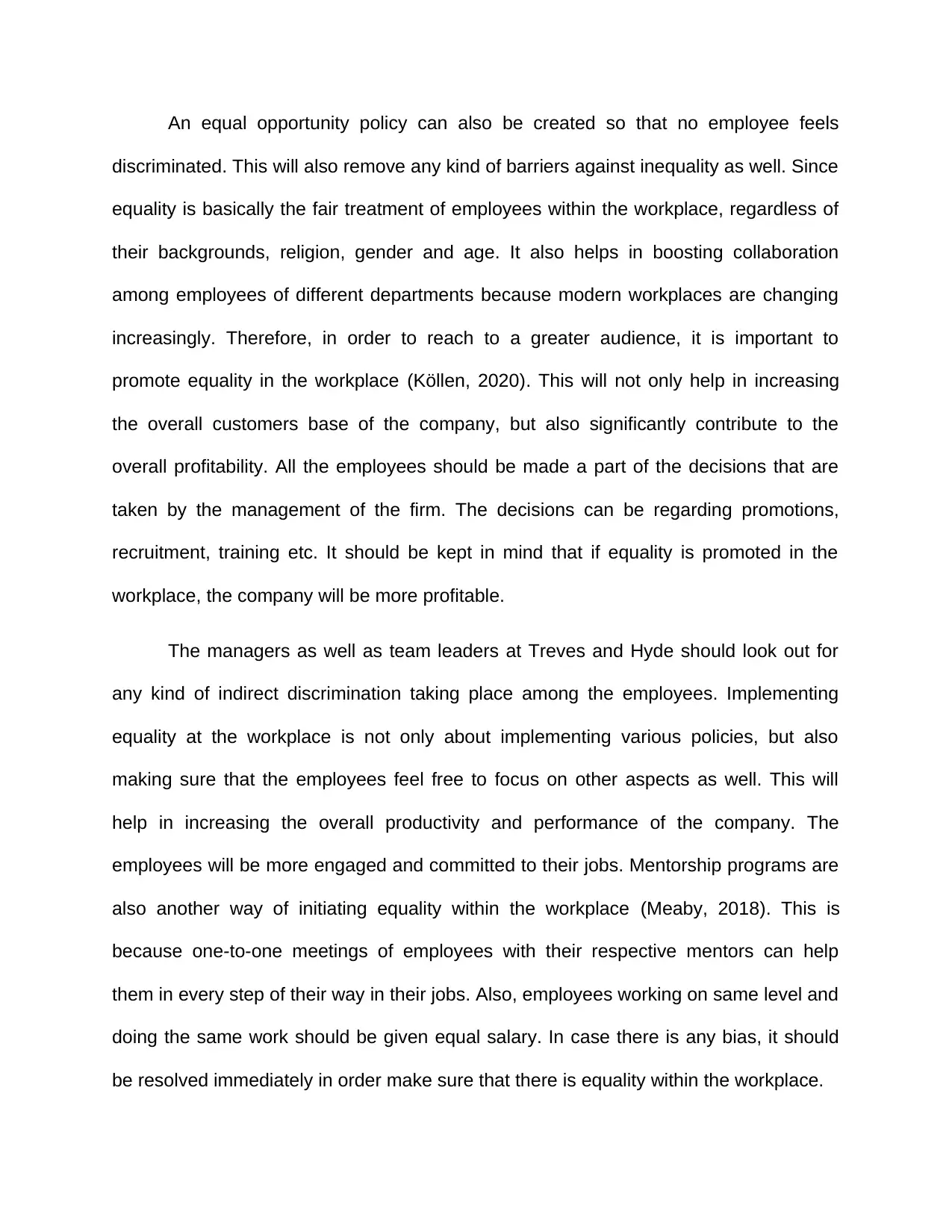
An equal opportunity policy can also be created so that no employee feels
discriminated. This will also remove any kind of barriers against inequality as well. Since
equality is basically the fair treatment of employees within the workplace, regardless of
their backgrounds, religion, gender and age. It also helps in boosting collaboration
among employees of different departments because modern workplaces are changing
increasingly. Therefore, in order to reach to a greater audience, it is important to
promote equality in the workplace (Köllen, 2020). This will not only help in increasing
the overall customers base of the company, but also significantly contribute to the
overall profitability. All the employees should be made a part of the decisions that are
taken by the management of the firm. The decisions can be regarding promotions,
recruitment, training etc. It should be kept in mind that if equality is promoted in the
workplace, the company will be more profitable.
The managers as well as team leaders at Treves and Hyde should look out for
any kind of indirect discrimination taking place among the employees. Implementing
equality at the workplace is not only about implementing various policies, but also
making sure that the employees feel free to focus on other aspects as well. This will
help in increasing the overall productivity and performance of the company. The
employees will be more engaged and committed to their jobs. Mentorship programs are
also another way of initiating equality within the workplace (Meaby, 2018). This is
because one-to-one meetings of employees with their respective mentors can help
them in every step of their way in their jobs. Also, employees working on same level and
doing the same work should be given equal salary. In case there is any bias, it should
be resolved immediately in order make sure that there is equality within the workplace.
discriminated. This will also remove any kind of barriers against inequality as well. Since
equality is basically the fair treatment of employees within the workplace, regardless of
their backgrounds, religion, gender and age. It also helps in boosting collaboration
among employees of different departments because modern workplaces are changing
increasingly. Therefore, in order to reach to a greater audience, it is important to
promote equality in the workplace (Köllen, 2020). This will not only help in increasing
the overall customers base of the company, but also significantly contribute to the
overall profitability. All the employees should be made a part of the decisions that are
taken by the management of the firm. The decisions can be regarding promotions,
recruitment, training etc. It should be kept in mind that if equality is promoted in the
workplace, the company will be more profitable.
The managers as well as team leaders at Treves and Hyde should look out for
any kind of indirect discrimination taking place among the employees. Implementing
equality at the workplace is not only about implementing various policies, but also
making sure that the employees feel free to focus on other aspects as well. This will
help in increasing the overall productivity and performance of the company. The
employees will be more engaged and committed to their jobs. Mentorship programs are
also another way of initiating equality within the workplace (Meaby, 2018). This is
because one-to-one meetings of employees with their respective mentors can help
them in every step of their way in their jobs. Also, employees working on same level and
doing the same work should be given equal salary. In case there is any bias, it should
be resolved immediately in order make sure that there is equality within the workplace.
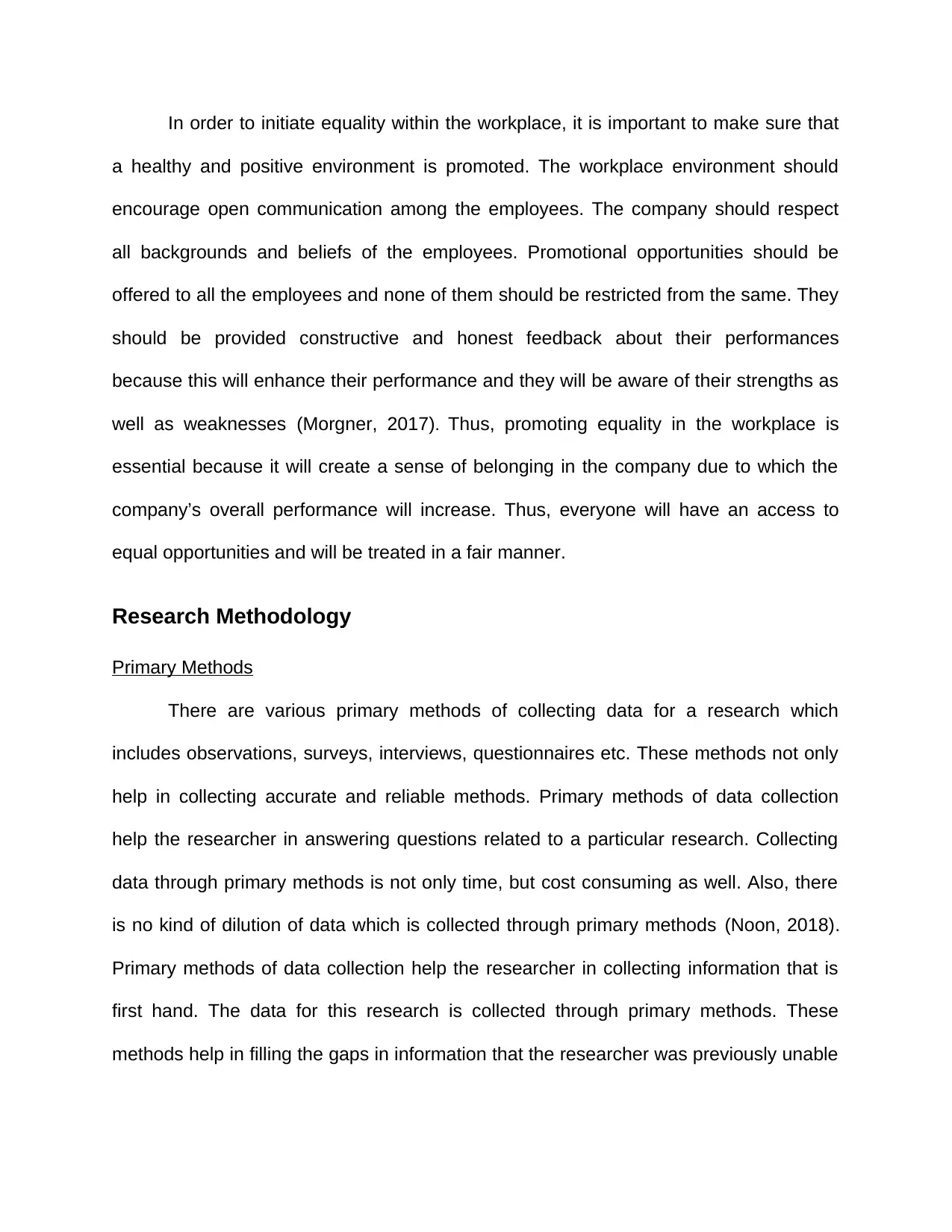
In order to initiate equality within the workplace, it is important to make sure that
a healthy and positive environment is promoted. The workplace environment should
encourage open communication among the employees. The company should respect
all backgrounds and beliefs of the employees. Promotional opportunities should be
offered to all the employees and none of them should be restricted from the same. They
should be provided constructive and honest feedback about their performances
because this will enhance their performance and they will be aware of their strengths as
well as weaknesses (Morgner, 2017). Thus, promoting equality in the workplace is
essential because it will create a sense of belonging in the company due to which the
company’s overall performance will increase. Thus, everyone will have an access to
equal opportunities and will be treated in a fair manner.
Research Methodology
Primary Methods
There are various primary methods of collecting data for a research which
includes observations, surveys, interviews, questionnaires etc. These methods not only
help in collecting accurate and reliable methods. Primary methods of data collection
help the researcher in answering questions related to a particular research. Collecting
data through primary methods is not only time, but cost consuming as well. Also, there
is no kind of dilution of data which is collected through primary methods (Noon, 2018).
Primary methods of data collection help the researcher in collecting information that is
first hand. The data for this research is collected through primary methods. These
methods help in filling the gaps in information that the researcher was previously unable
a healthy and positive environment is promoted. The workplace environment should
encourage open communication among the employees. The company should respect
all backgrounds and beliefs of the employees. Promotional opportunities should be
offered to all the employees and none of them should be restricted from the same. They
should be provided constructive and honest feedback about their performances
because this will enhance their performance and they will be aware of their strengths as
well as weaknesses (Morgner, 2017). Thus, promoting equality in the workplace is
essential because it will create a sense of belonging in the company due to which the
company’s overall performance will increase. Thus, everyone will have an access to
equal opportunities and will be treated in a fair manner.
Research Methodology
Primary Methods
There are various primary methods of collecting data for a research which
includes observations, surveys, interviews, questionnaires etc. These methods not only
help in collecting accurate and reliable methods. Primary methods of data collection
help the researcher in answering questions related to a particular research. Collecting
data through primary methods is not only time, but cost consuming as well. Also, there
is no kind of dilution of data which is collected through primary methods (Noon, 2018).
Primary methods of data collection help the researcher in collecting information that is
first hand. The data for this research is collected through primary methods. These
methods help in filling the gaps in information that the researcher was previously unable
⊘ This is a preview!⊘
Do you want full access?
Subscribe today to unlock all pages.

Trusted by 1+ million students worldwide
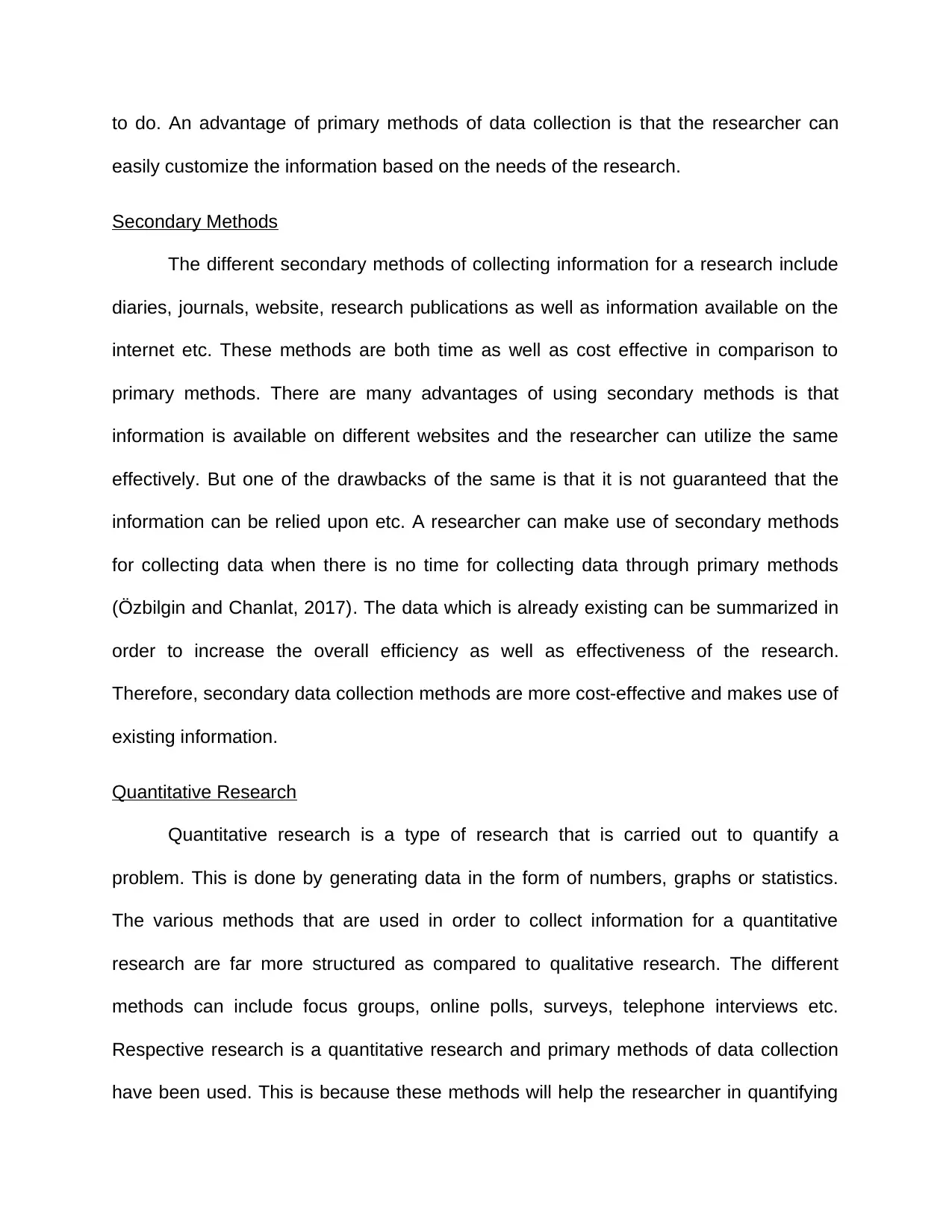
to do. An advantage of primary methods of data collection is that the researcher can
easily customize the information based on the needs of the research.
Secondary Methods
The different secondary methods of collecting information for a research include
diaries, journals, website, research publications as well as information available on the
internet etc. These methods are both time as well as cost effective in comparison to
primary methods. There are many advantages of using secondary methods is that
information is available on different websites and the researcher can utilize the same
effectively. But one of the drawbacks of the same is that it is not guaranteed that the
information can be relied upon etc. A researcher can make use of secondary methods
for collecting data when there is no time for collecting data through primary methods
(Özbilgin and Chanlat, 2017). The data which is already existing can be summarized in
order to increase the overall efficiency as well as effectiveness of the research.
Therefore, secondary data collection methods are more cost-effective and makes use of
existing information.
Quantitative Research
Quantitative research is a type of research that is carried out to quantify a
problem. This is done by generating data in the form of numbers, graphs or statistics.
The various methods that are used in order to collect information for a quantitative
research are far more structured as compared to qualitative research. The different
methods can include focus groups, online polls, surveys, telephone interviews etc.
Respective research is a quantitative research and primary methods of data collection
have been used. This is because these methods will help the researcher in quantifying
easily customize the information based on the needs of the research.
Secondary Methods
The different secondary methods of collecting information for a research include
diaries, journals, website, research publications as well as information available on the
internet etc. These methods are both time as well as cost effective in comparison to
primary methods. There are many advantages of using secondary methods is that
information is available on different websites and the researcher can utilize the same
effectively. But one of the drawbacks of the same is that it is not guaranteed that the
information can be relied upon etc. A researcher can make use of secondary methods
for collecting data when there is no time for collecting data through primary methods
(Özbilgin and Chanlat, 2017). The data which is already existing can be summarized in
order to increase the overall efficiency as well as effectiveness of the research.
Therefore, secondary data collection methods are more cost-effective and makes use of
existing information.
Quantitative Research
Quantitative research is a type of research that is carried out to quantify a
problem. This is done by generating data in the form of numbers, graphs or statistics.
The various methods that are used in order to collect information for a quantitative
research are far more structured as compared to qualitative research. The different
methods can include focus groups, online polls, surveys, telephone interviews etc.
Respective research is a quantitative research and primary methods of data collection
have been used. This is because these methods will help the researcher in quantifying
Paraphrase This Document
Need a fresh take? Get an instant paraphrase of this document with our AI Paraphraser
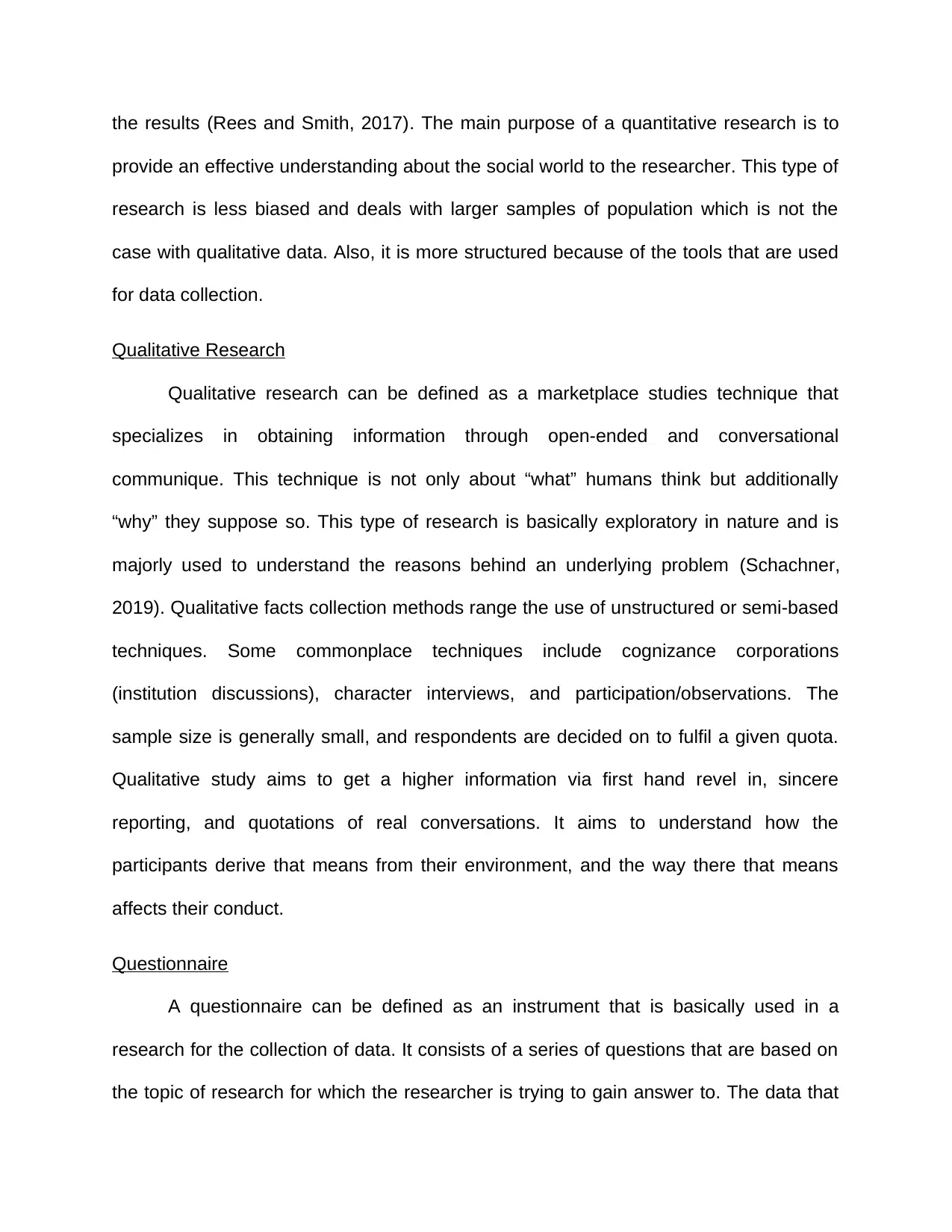
the results (Rees and Smith, 2017). The main purpose of a quantitative research is to
provide an effective understanding about the social world to the researcher. This type of
research is less biased and deals with larger samples of population which is not the
case with qualitative data. Also, it is more structured because of the tools that are used
for data collection.
Qualitative Research
Qualitative research can be defined as a marketplace studies technique that
specializes in obtaining information through open-ended and conversational
communique. This technique is not only about “what” humans think but additionally
“why” they suppose so. This type of research is basically exploratory in nature and is
majorly used to understand the reasons behind an underlying problem (Schachner,
2019). Qualitative facts collection methods range the use of unstructured or semi-based
techniques. Some commonplace techniques include cognizance corporations
(institution discussions), character interviews, and participation/observations. The
sample size is generally small, and respondents are decided on to fulfil a given quota.
Qualitative study aims to get a higher information via first hand revel in, sincere
reporting, and quotations of real conversations. It aims to understand how the
participants derive that means from their environment, and the way there that means
affects their conduct.
Questionnaire
A questionnaire can be defined as an instrument that is basically used in a
research for the collection of data. It consists of a series of questions that are based on
the topic of research for which the researcher is trying to gain answer to. The data that
provide an effective understanding about the social world to the researcher. This type of
research is less biased and deals with larger samples of population which is not the
case with qualitative data. Also, it is more structured because of the tools that are used
for data collection.
Qualitative Research
Qualitative research can be defined as a marketplace studies technique that
specializes in obtaining information through open-ended and conversational
communique. This technique is not only about “what” humans think but additionally
“why” they suppose so. This type of research is basically exploratory in nature and is
majorly used to understand the reasons behind an underlying problem (Schachner,
2019). Qualitative facts collection methods range the use of unstructured or semi-based
techniques. Some commonplace techniques include cognizance corporations
(institution discussions), character interviews, and participation/observations. The
sample size is generally small, and respondents are decided on to fulfil a given quota.
Qualitative study aims to get a higher information via first hand revel in, sincere
reporting, and quotations of real conversations. It aims to understand how the
participants derive that means from their environment, and the way there that means
affects their conduct.
Questionnaire
A questionnaire can be defined as an instrument that is basically used in a
research for the collection of data. It consists of a series of questions that are based on
the topic of research for which the researcher is trying to gain answer to. The data that
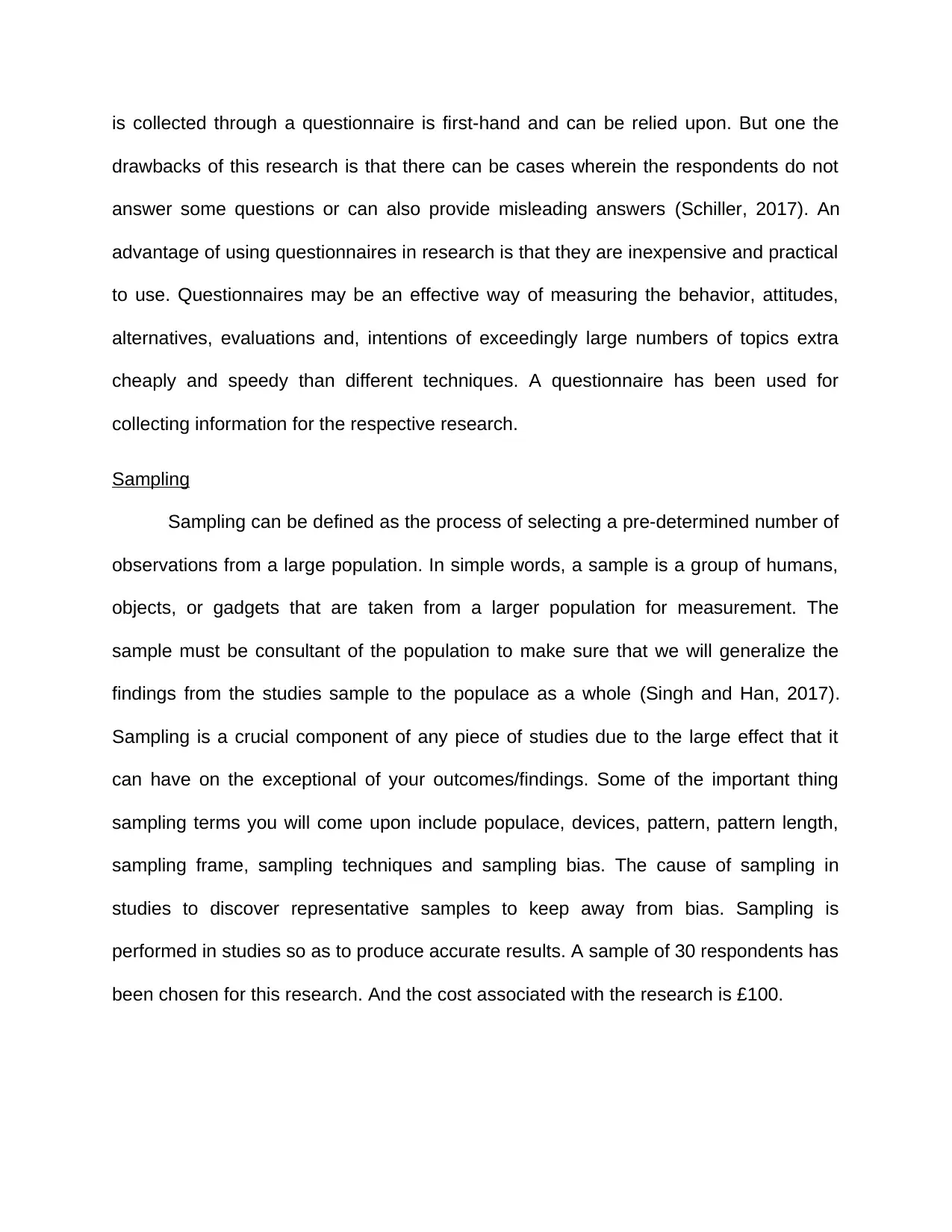
is collected through a questionnaire is first-hand and can be relied upon. But one the
drawbacks of this research is that there can be cases wherein the respondents do not
answer some questions or can also provide misleading answers (Schiller, 2017). An
advantage of using questionnaires in research is that they are inexpensive and practical
to use. Questionnaires may be an effective way of measuring the behavior, attitudes,
alternatives, evaluations and, intentions of exceedingly large numbers of topics extra
cheaply and speedy than different techniques. A questionnaire has been used for
collecting information for the respective research.
Sampling
Sampling can be defined as the process of selecting a pre-determined number of
observations from a large population. In simple words, a sample is a group of humans,
objects, or gadgets that are taken from a larger population for measurement. The
sample must be consultant of the population to make sure that we will generalize the
findings from the studies sample to the populace as a whole (Singh and Han, 2017).
Sampling is a crucial component of any piece of studies due to the large effect that it
can have on the exceptional of your outcomes/findings. Some of the important thing
sampling terms you will come upon include populace, devices, pattern, pattern length,
sampling frame, sampling techniques and sampling bias. The cause of sampling in
studies to discover representative samples to keep away from bias. Sampling is
performed in studies so as to produce accurate results. A sample of 30 respondents has
been chosen for this research. And the cost associated with the research is £100.
drawbacks of this research is that there can be cases wherein the respondents do not
answer some questions or can also provide misleading answers (Schiller, 2017). An
advantage of using questionnaires in research is that they are inexpensive and practical
to use. Questionnaires may be an effective way of measuring the behavior, attitudes,
alternatives, evaluations and, intentions of exceedingly large numbers of topics extra
cheaply and speedy than different techniques. A questionnaire has been used for
collecting information for the respective research.
Sampling
Sampling can be defined as the process of selecting a pre-determined number of
observations from a large population. In simple words, a sample is a group of humans,
objects, or gadgets that are taken from a larger population for measurement. The
sample must be consultant of the population to make sure that we will generalize the
findings from the studies sample to the populace as a whole (Singh and Han, 2017).
Sampling is a crucial component of any piece of studies due to the large effect that it
can have on the exceptional of your outcomes/findings. Some of the important thing
sampling terms you will come upon include populace, devices, pattern, pattern length,
sampling frame, sampling techniques and sampling bias. The cause of sampling in
studies to discover representative samples to keep away from bias. Sampling is
performed in studies so as to produce accurate results. A sample of 30 respondents has
been chosen for this research. And the cost associated with the research is £100.
⊘ This is a preview!⊘
Do you want full access?
Subscribe today to unlock all pages.

Trusted by 1+ million students worldwide
1 out of 26
Related Documents
Your All-in-One AI-Powered Toolkit for Academic Success.
+13062052269
info@desklib.com
Available 24*7 on WhatsApp / Email
![[object Object]](/_next/static/media/star-bottom.7253800d.svg)
Unlock your academic potential
Copyright © 2020–2025 A2Z Services. All Rights Reserved. Developed and managed by ZUCOL.




